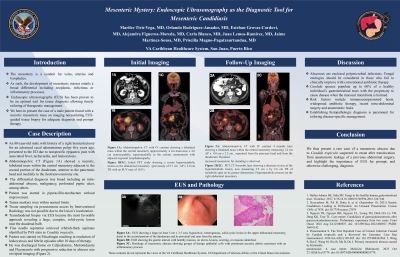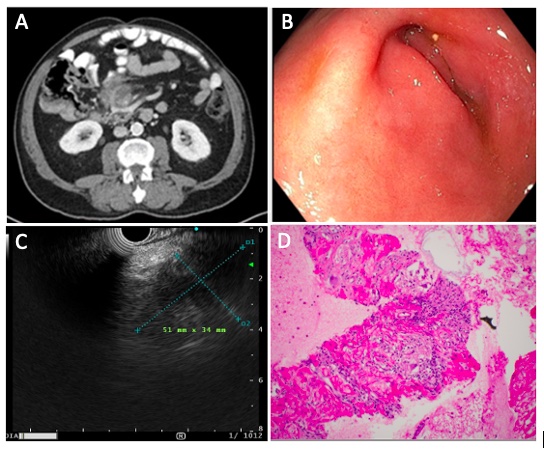Sunday Poster Session
Category: Interventional Endoscopy
P1098 - Mesenteric Mystery: Endoscopic Ultrasonography as the Diagnostic Tool for Mesenteric Candidiasis
Sunday, October 27, 2024
3:30 PM - 7:00 PM ET
Location: Exhibit Hall E

Has Audio

Marilee Tiru-Vega, MD
VA Caribbean Healthcare System
San Juan, PR
Presenting Author(s)
Marilee Tirú-Vega, MD, Orlando Rodriguez-Amador, MD, Esteban Grovas-Cordovi, MD, Alejandra Figueroa-Moreda, MD, Carla Blanco, MD, Juan Lemos-Ramirez, MD, Jaime Martinez-Souss, MD, Priscilla Magno-Pagatzaurtundua, MD
VA Caribbean Healthcare System, San Juan, Puerto Rico
Introduction: The mesentery is a conduit for veins, arteries and lymphatics. As such, the development of mesenteric masses entails a broad differential including neoplastic, infectious or inflammatory processes. Endoscopic ultrasonography (EUS) has been proven to be an optimal tool for tissue diagnosis allowing timely tailoring of therapeutic management. We here-in present the case of a male patient found with a necrotic mesenteric mass on imaging necessitating EUS-guided tissue biopsy for adequate diagnosis and prompt therapy.
Case Description/Methods: An 80-year-old male with history of a right hemicolectomy for an advanced cecal adenomatous polyp, presented to the ED due to nonspecific epigastric pain with associated fever, tachycardia, and leukocytosis. Abdominopelvic CT showed a necrotic, lobulated mass within the central mesentery adjacent to the second portion of the duodenum, anterior to the pancreatic head and medially to the ileotransversotomy site. The differential diagnosis was broad including an intra-abdominal abscess, malignancy, perforated peptic ulcer, among others. Patient was started in piperacillin-tazobactam without improvement. Tumor markers were within normal limits. Tissue sampling via percutaneous access by Interventional Radiology was not possible due to the lesion’s localization. Transduodenal biopsy via EUS became the most favorable approach revealing a large, complex, solid-cystic lesion near the duodenal bulb. Fine needle aspiration retrieved whitish-thick aspirates identified by PAS stain as Candida tropicalis. Patient was started on Micafungin resulting in resolution of leukocytosis and febrile episodes, and progressive reduction in abscess size on repeat imaging.
Discussion: Abscesses are enclosed polymicrobial infections. Fungal etiologies should be considered in those who fail to clinically improve with conventional antibiotic therapy. Candida species populate up to 60% of a healthy individual’s gastrointestinal tract with the propensity to cause disease when the mucosal microbiota is harmed. Risk factors include immunocompromised hosts, widespread antibiotic therapy, recent intra-abdominal surgery and anastomotic leaks. Establishing histopathologic diagnosis is paramount for tailoring disease-specific management. We thus present a rare case of a mesenteric abscess due to Candida tropicalis suspected to ensue after translocation from anastomotic leakage of a previous abdominal surgery, and highlight the importance of EUS for prompt, and otherwise challenging, diagnosis.

Disclosures:
Marilee Tirú-Vega, MD, Orlando Rodriguez-Amador, MD, Esteban Grovas-Cordovi, MD, Alejandra Figueroa-Moreda, MD, Carla Blanco, MD, Juan Lemos-Ramirez, MD, Jaime Martinez-Souss, MD, Priscilla Magno-Pagatzaurtundua, MD. P1098 - Mesenteric Mystery: Endoscopic Ultrasonography as the Diagnostic Tool for Mesenteric Candidiasis, ACG 2024 Annual Scientific Meeting Abstracts. Philadelphia, PA: American College of Gastroenterology.
VA Caribbean Healthcare System, San Juan, Puerto Rico
Introduction: The mesentery is a conduit for veins, arteries and lymphatics. As such, the development of mesenteric masses entails a broad differential including neoplastic, infectious or inflammatory processes. Endoscopic ultrasonography (EUS) has been proven to be an optimal tool for tissue diagnosis allowing timely tailoring of therapeutic management. We here-in present the case of a male patient found with a necrotic mesenteric mass on imaging necessitating EUS-guided tissue biopsy for adequate diagnosis and prompt therapy.
Case Description/Methods: An 80-year-old male with history of a right hemicolectomy for an advanced cecal adenomatous polyp, presented to the ED due to nonspecific epigastric pain with associated fever, tachycardia, and leukocytosis. Abdominopelvic CT showed a necrotic, lobulated mass within the central mesentery adjacent to the second portion of the duodenum, anterior to the pancreatic head and medially to the ileotransversotomy site. The differential diagnosis was broad including an intra-abdominal abscess, malignancy, perforated peptic ulcer, among others. Patient was started in piperacillin-tazobactam without improvement. Tumor markers were within normal limits. Tissue sampling via percutaneous access by Interventional Radiology was not possible due to the lesion’s localization. Transduodenal biopsy via EUS became the most favorable approach revealing a large, complex, solid-cystic lesion near the duodenal bulb. Fine needle aspiration retrieved whitish-thick aspirates identified by PAS stain as Candida tropicalis. Patient was started on Micafungin resulting in resolution of leukocytosis and febrile episodes, and progressive reduction in abscess size on repeat imaging.
Discussion: Abscesses are enclosed polymicrobial infections. Fungal etiologies should be considered in those who fail to clinically improve with conventional antibiotic therapy. Candida species populate up to 60% of a healthy individual’s gastrointestinal tract with the propensity to cause disease when the mucosal microbiota is harmed. Risk factors include immunocompromised hosts, widespread antibiotic therapy, recent intra-abdominal surgery and anastomotic leaks. Establishing histopathologic diagnosis is paramount for tailoring disease-specific management. We thus present a rare case of a mesenteric abscess due to Candida tropicalis suspected to ensue after translocation from anastomotic leakage of a previous abdominal surgery, and highlight the importance of EUS for prompt, and otherwise challenging, diagnosis.

Figure: Figure 1A: Abdominopelvic CT with IV contrast showing a lobulated mass within the central mesentery approximately 4 cm transverse x 4.6 cm craniocaudally, superomedially to the colonic anastomosis with adjacent regional lymphadenopathy. 1B: Endoscopic ultrasonography showing the antrum with healthy mucosa, no ulcers, lesions, scarring, or erosions identified. 1C: Endoscopic ultrasonography showing a large (at least 5 cm x 3.5 cm), hypoechoic, heterogenous, solid-cystic lesion in the upper abdominal mesentery, distal to the second portion of the duodenum and its proximal end seen from the antrum. 1D: Cytology of mesenteric abscess showing groups of benign epithelial cells with prominent necrotic debris consistent with an inflammatory process.
Disclosures:
Marilee Tirú-Vega indicated no relevant financial relationships.
Orlando Rodriguez-Amador indicated no relevant financial relationships.
Esteban Grovas-Cordovi indicated no relevant financial relationships.
Alejandra Figueroa-Moreda indicated no relevant financial relationships.
Carla Blanco indicated no relevant financial relationships.
Juan Lemos-Ramirez indicated no relevant financial relationships.
Jaime Martinez-Souss indicated no relevant financial relationships.
Priscilla Magno-Pagatzaurtundua indicated no relevant financial relationships.
Marilee Tirú-Vega, MD, Orlando Rodriguez-Amador, MD, Esteban Grovas-Cordovi, MD, Alejandra Figueroa-Moreda, MD, Carla Blanco, MD, Juan Lemos-Ramirez, MD, Jaime Martinez-Souss, MD, Priscilla Magno-Pagatzaurtundua, MD. P1098 - Mesenteric Mystery: Endoscopic Ultrasonography as the Diagnostic Tool for Mesenteric Candidiasis, ACG 2024 Annual Scientific Meeting Abstracts. Philadelphia, PA: American College of Gastroenterology.
